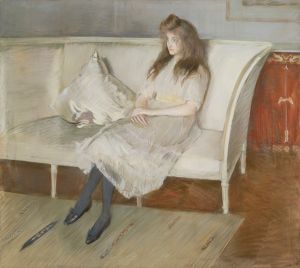
Little Boy on a Stool
A hand-painted replica of Eastman Johnson’s masterpiece Little Boy on a Stool, meticulously crafted by professional artists to capture the true essence of the original. Each piece is created with museum-quality canvas and rare mineral pigments, carefully painted by experienced artists with delicate brushstrokes and rich, layered colors to perfectly recreate the texture of the original artwork. Unlike machine-printed reproductions, this hand-painted version brings the painting to life, infused with the artist’s emotions and skill in every stroke. Whether for personal collection or home decoration, it instantly elevates the artistic atmosphere of any space.
"Little Boy on a Stool" is a painting by the American artist Eastman Johnson, who is renowned for his genre scenes and portraits that capture the essence of 19th-century American life. Johnson, born in 1824 in Lovell, Maine, was a pivotal figure in American art, often compared to the likes of Winslow Homer and Thomas Eakins for his ability to depict everyday life with authenticity and emotional depth.
The painting "Little Boy on a Stool" exemplifies Johnson's skill in portraying intimate and domestic scenes. Although specific details about the painting's creation, such as its exact date and current location, are not widely documented, it is consistent with Johnson's broader body of work that often focused on themes of childhood, family, and rural life. His works are characterized by their warm, realistic portrayal of subjects, often imbued with a sense of nostalgia and simplicity.
Eastman Johnson's technique in "Little Boy on a Stool" likely reflects his academic training and his exposure to European art. He studied in Düsseldorf and later in The Hague, where he was influenced by the Dutch masters, particularly in their use of light and shadow and their attention to detail. This influence is evident in his adept use of chiaroscuro and his ability to capture the textures of different materials, from the softness of a child's skin to the roughness of wooden furniture.
The subject matter of a young boy seated on a stool is typical of Johnson's interest in the innocence and simplicity of childhood. His paintings often convey a narrative, inviting viewers to ponder the thoughts and emotions of his subjects. In this work, the boy's posture, expression, and the surrounding environment would have been carefully considered to evoke a particular mood or story, although the specifics of this narrative are left to the viewer's interpretation.
Johnson's contribution to American art extends beyond his technical prowess; he played a significant role in shaping the nation's cultural identity during a period of significant change. His works often reflect the social and political climate of the time, capturing the nuances of American life during the 19th century. While "Little Boy on a Stool" may not directly address the broader themes of his more politically charged works, it nonetheless contributes to the rich tapestry of American genre painting.
Throughout his career, Eastman Johnson received numerous accolades and was a founding member of the Metropolitan Museum of Art in New York City. His legacy is preserved in the collections of major institutions, where his works continue to be studied and appreciated for their artistic and historical significance.
In summary, "Little Boy on a Stool" is a testament to Eastman Johnson's mastery of genre painting and his ability to capture the quiet, everyday moments of American life with sensitivity and skill. While specific details about this particular painting are limited, it remains an integral part of understanding Johnson's impact on American art.













